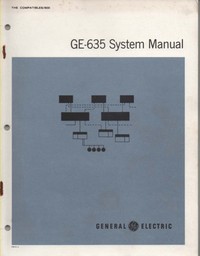GE-635 System Manual
| Home > Browse Our Collection > Manuals > General Electric > GE-635 System Manual |
|
The GE-600 series was a family of 36-bit mainframe computers originating in the 1960s, built by General Electric (GE). When GE left the mainframe business the line was sold to Honeywell, who built similar systems into the 1990s as the division moved to Groupe Bull and then NEC. Originally the operating system for the 600-series computers was GECOS, developed by GE beginning in 1962. The GE-635 was used for the Dartmouth Time Sharing System starting in 1965. It was developed by a team led by John Couleur out of work they had done for the military MISTRAM project in 1959. MISTRAM was a tracking system that was used on a number of projects (including Project Apollo) and the Air Force required a data-collection computer to be installed in a tracking station downrange from Cape Canaveral. The data would eventually be shared with the 36-bit IBM 7094 machine at the Cape, so the computer would likely have to be 36-bits as well (why they didn't use an IBM 7094 is something of a mystery). GE built a machine called the M236 for the task, and as a result of the 36-bit needs, it ended up acting a lot like the 7094. In fact GE offered a box to connect to the 635 called a 9SA that actually allowed the 635 to run 7094 programs. GE originally hadn't intended on entering the commercial computer market with the machine. However by the early 1960s GE was the largest user of IBM mainframes, and producing their own machines seemed like an excellent way to lower the costs of their computing department. In one estimate the cost of development would be paid for in a single year of IBM rental fees. Many remained skeptical, but after a year of internal wrangling, the project to commercialize the M236 eventually got the go-ahead in February 1963. The machine was originally offered as the main GE-635, and the slower but compatible GE-625 and GE-615. While most were single processor systems, the 635 could be configured with four CPUs and up to four input/output controllers (IOC's) each with up to 16 Common Peripheral Interface Channels. The 635 was likely the first example of a general purpose SMP system (although the GECOS/GCOS software treated the processors as a master, and up to three slaves). The 600 line consisted of six models: the 605, 615, 625, 635, 645, and 655. This is a comprehensive illustrated leaflet which is also online in PDF format at http://www.bitsavers.org/pdf/ge/GE-6xx/CPB-371A_GE-635_System_Man_Jul64.pdf We are extremely grateful to both Dawn and Kim Wakefield for the kind donation of the collection of their late father Richard Wakefield.
This exhibit has a reference ID of CH15671. Please quote this reference ID in any communication with the Centre for Computing History. |
Click on the Images For Detail
|










